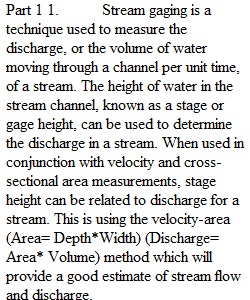


Q FE 430 Problem Set 4 - Discharge Measurements and analysis (45 points) Complete this assignment by Sunday of Week 5 at 11:59 PM. Submit your typed solutions in one of the following formats: .pdf, .doc, .docx. Include appropriate units with numerical solutions. Objective: To learn about stream gauging. You will work with data collected to estimate stream discharge. You will also learn about the development of rating curves. Background: The process of measuring stream flow or discharge (volume rate of flow) is called stream gauging. There are numerous methods of stream gauging, including direct methods, such as volumetric gauging, as well as indirect methods involving stage-discharge relations, or rating curves. You will be using the direct velocity-area gauging method, which involves numerical integration of depth and velocity measurements at successive locations along a stream cross-section. In the second part of this problem set you will be using a rating curve (see here) derived for this site to make some predictions. Part I: Velocity-Area method: The data you will analyze was collected using a measuring tape and a current meter (like this). Velocity was measured across a river with the flow meter assuming that the average vertical velocity can be estimated at 0.4 of the depth off the bottom, or 0.6 depth from the water surface (i.e., for a depth of 1 meter flow you would measure the velocity at 40 cm (0.4m) from the bed). Along with velocity other data collected included depth and distance along the transect channel size. Recall that discharge (Q) is: Q=VA where V is velocity and A is area. The data collected across a river is intended to “divide” the river into smaller areas with different velocities. Then the total Q is the sum of the velocity x area product of these smaller areas. Consider the figure below. Area velocity where q is the discharge of a vertical or an individual segment of the cross section; w is the width of individual segments of the cross section; x is the distance from the initial point; y is the depth of the two verticals making up the segments; v is the measured velocity at the verticals making up the segment; and Q is the total discharge through the cross section. Example of data recording and calculations Raw Data Area / Velocity Calculations Discharge Distance Depth (m) Vel (m/s) Width (m) Mean Depth (m) Area (m2) Mean Vel (m/s) q (m3/s) 0 0.0 0.00 2 0.5 0.13 2.0 0.25 0.5 0.07 0.03 4 0.9 0.31 2.0 0.70 1.4 0.22 0.31 6 1.2 0.44 2.0 1.05 2.1 0.38 0.79 8 1.2 0.50 2.0 1.20 2.4 0.47 1.13 10 1.3 0.28 2.0 1.25 2.5 0.39 0.98 12 1.0 0.20 2.0 1.15 2.3 0.24 0.55 14 0.9 0.15 2.0 0.95 1.9 0.18 0.33 15.2 0.9 0.00 1.2 0.90 1.08 0.08 0.08 Total area (m2) 14.18 Total Q (m3/s) 4.20 You will work with the data posted in canvas (Velocity_area_method_data.xlsx). The first line given as an example. Part II: Use the information posted in Canvas (Oak_Creek_Rating Curve.xlsx) to calculate a rating curve (stage in x-axis and discharge in y-axis). Use the rating curve (hint: the equation) to estimate the discharge for stage values of 0.7, 0.5, and 0.15 m. I suggest you fit both a power function and a 2nd order polynomial. Include in your report: Part I (5 points) A summary of the methodology used to estimate discharge (between 100-150 words) (10 points) The total discharge calculations in m3/s (include the table showing your calculations) (5 points) The mean velocity (total Q divided by total cross-sectional area) both in m/s and f/s. Part II (5 points) Figures with the calculated rating curves and the equations (10 points) Estimates of discharge for stage values of 0.7m, 0.5m, and 0.15 m (10 points) A paragraph (100-200 words) explaining what difference the selection of the function makes in the estimated discharge values. How robust do you think the estimates are for the different stages (0.7m, 0.5m, and 0.15m).
View Related Questions